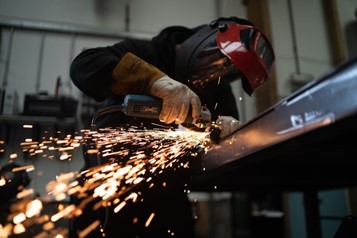
For industrial manufacturing and automation, downtime is the enemy. When critical electronic or robotic equipment fails, it can halt entire production lines, leading to costly delays, lost revenue, and supply chain disruptions. Ensuring the availability of high-quality replacement components, such as FANUC parts, is essential for maintaining seamless operations. Implementing effective industrial equipment repair and preventative maintenance strategies can significantly reduce downtime, keeping systems efficient, reliable, and cost-effective.
This article explores key strategies for minimizing equipment downtime through efficient repair practices, proactive maintenance, and smart troubleshooting methods. Whether you're managing a high-volume manufacturing facility or an advanced automation system, these best practices—along with quick access to essential components will help keep your industrial equipment running smoothly.
Before diving into repair strategies, it's important to understand why minimizing downtime is so critical. Downtime in industrial settings can be categorized into two types:
Planned Downtime: This includes scheduled maintenance, inspections, and system upgrades that are intentionally set up to minimize disruptions.
Unplanned Downtime: This occurs due to unexpected equipment failures, power issues, or operator errors and can have severe financial consequences.
The true cost of unplanned downtime includes:
Lost production time – Every minute an assembly line is down means lost output.
Increased labor costs – Overtime pay for maintenance crews working on urgent repairs.
Missed deadlines – Late shipments can damage customer relationships.
Expensive emergency repairs – Urgent repairs often cost more due to expedited parts and labor.
For companies that rely on robotics, servo motors, and industrial electronics, unexpected downtime can be even more costly due to the specialized nature of repairs and the complexity of the equipment.
One of the most effective ways to reduce downtime is by identifying potential failures before they happen. Predictive maintenance uses real-time data and analytics to monitor equipment performance and detect signs of wear, overheating, or electrical failures before they lead to breakdowns.
Best practices include:
Many industrial equipment failures require replacement components such as motors, electronic circuit boards, fuses, and actuators. One of the fastest ways to reduce repair time is to keep critical spare parts in stock rather than waiting for an emergency order.
Key spare parts to stock for industrial electronics and robotics:
Maintaining an inventory of commonly used spare parts ensures that repairs can be completed quickly, avoiding costly delays caused by long lead times from suppliers.
Having a dedicated in-house repair team or a reliable third-party service provider can dramatically reduce downtime when equipment malfunctions. An effective repair strategy includes:
24/7 emergency support – Partner with repair specialists who offer around-the-clock service for mission-critical equipment.
Cross-trained technicians – Train maintenance personnel on multiple types of industrial equipment so they can diagnose and fix issues across different systems.
Remote troubleshooting – Utilize augmented reality (AR) support or remote diagnostics to allow off-site experts to assist in real time.
By streamlining the repair process, companies can significantly cut down on the time it takes to identify, troubleshoot, and fix equipment failures.

Heat-related failures are a major cause of downtime in industrial electronics and servo systems. Overheating can damage PCBs, sensors, and motor windings, leading to costly repairs.
Ways to improve thermal management:
By maintaining optimal operating temperatures, companies can extend the lifespan of their industrial equipment and prevent unnecessary failures.
One of the biggest challenges in industrial repair is incompatibility between different machines and parts. Standardizing equipment and components across the facility can simplify repairs and reduce the number of unique spare parts required.
How standardization improves repair efficiency:
By choosing uniform brands, controllers, and communication protocols, companies can significantly streamline their maintenance and repair operations.
Regular system diagnostics are essential for early detection of performance issues. Automated monitoring software can track equipment conditions in real time and alert technicians to potential failures before they occur.
Key benefits include faster problem identification, as alerts provide instant data on failing components, allowing for quicker response times. Additionally, it leads to reduced manual inspections, saving valuable time by continuously monitoring systems. The system also offers historical data analysis, which helps detect recurring issues and optimize maintenance schedules for more efficient long-term planning. Using automation in diagnostics allows maintenance teams to be more proactive rather than reactive, reducing unexpected breakdowns and downtime.
While in-house teams can handle many repairs, some complex industrial equipment requires specialized expertise. Partnering with a trusted repair service provider ensures that servo motors, robotic arms, and PLC systems are repaired quickly and correctly, with certified technicians handling repairs according to manufacturer specifications. Additionally, expedited service options are available for critical equipment failures, helping to minimize the impact of downtime. Having a go-to repair partner also streamlines the process of sourcing parts, diagnosing issues, and performing repairs, significantly reducing downtime and keeping operations running smoothly.
In industrial settings, minimizing downtime is crucial for maintaining efficiency and profitability. By implementing predictive maintenance, stocking essential spare parts, training skilled technicians, and improving thermal management, companies can reduce the impact of equipment failures and streamline repairs.
Additionally, automation, standardization, and strategic partnerships can further enhance response times and reliability. Whether you operate robotic assembly lines, servo-driven machinery, or complex electronic control systems, following these strategies will help ensure that downtime is kept to an absolute minimum—allowing production to run smoothly and efficiently.